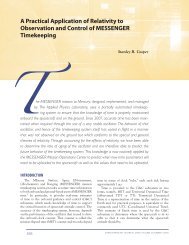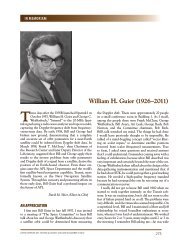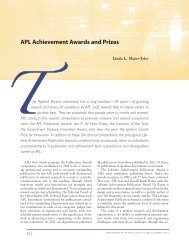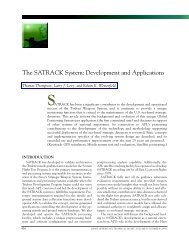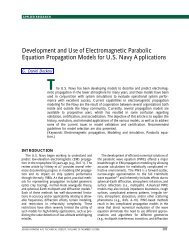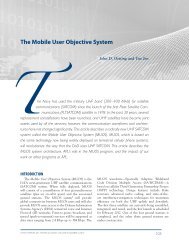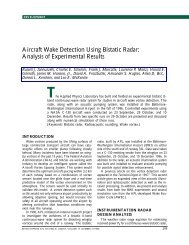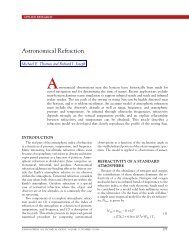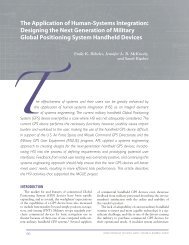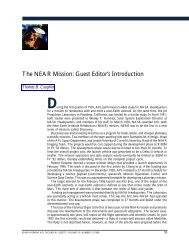Operational Evaluation for Evolutionary Sonars - Johns Hopkins ...
Operational Evaluation for Evolutionary Sonars - Johns Hopkins ...
Operational Evaluation for Evolutionary Sonars - Johns Hopkins ...
Create successful ePaper yourself
Turn your PDF publications into a flip-book with our unique Google optimized e-Paper software.
B. O. BATES, R. CALHOUN, AND D. E. GRANT<br />
with relying on real-time contact detections as absolute<br />
truth. Post-analysis allows the analyst to take advantage<br />
of knowing where in azimuth and range the exercise<br />
contact is and identifi es contact behaviors such as<br />
speed, depth, and propulsion mode changes, which help<br />
to verify that the sources detected are, in fact, from the<br />
exercise contact and not from interfering contacts.<br />
First pass analysis is conducted using the sonar system<br />
under evaluation in the most sensitive lineup. This<br />
lineup may not be feasible <strong>for</strong> real-time search because<br />
of display overload, but it takes advantage of high-resolution<br />
verniers and optimum update rates. This pass will<br />
be used to establish what sources from the contact of<br />
interest are detectable on any of the system displays at<br />
an operationally signifi cant range and will answer the<br />
most basic question: Can we detect the contact with<br />
our current array and processing technology? Because<br />
the lineup used <strong>for</strong> fi r st pa s s a n a lysi s is not necessarily<br />
feasible <strong>for</strong> real-time search, only a cursory comparison<br />
is made between the post-analysis results and real-time<br />
operator detections.<br />
Second pass analysis is per<strong>for</strong>med with the system<br />
confi gured in accordance with current operational<br />
guidance. If such guidance has not been <strong>for</strong>malized,<br />
the second pass is made with the system confi gured in<br />
accordance with the evaluation plat<strong>for</strong>m’s search plan.<br />
The primary objective of second pass analysis is to<br />
determine if the contact of interest is detectable on the<br />
system search displays when the system is operated in<br />
accordance with current operational guidance. System<br />
per<strong>for</strong>mance during second pass analysis and real-time<br />
operator detections are compared to determine if current<br />
operational guidance helps the operator detect the<br />
contact of interest. <strong>Operational</strong> test personnel observations<br />
address issues such as whether the search plan was<br />
generated using the current guidance, and whether the<br />
search plan was adhered to during the evaluation.<br />
When post-analysis shows that contact sources—<br />
available to the operator when the system under evaluation<br />
was operated in accordance with available operational<br />
guidance—were not detected in real time, it is<br />
necessary to look at operator training. These questions<br />
must be asked: Did the operators receive training in<br />
the proper operation of the system? Were the operators<br />
familiar with the test contact acoustic vulnerabilities?<br />
Did the search plan support contact detection? Observations<br />
by the embarked test team can provide valuable<br />
feedback to Navy training commands and commands<br />
tasked with developing operational guidance. The<br />
embarked test team also makes observations regarding<br />
watch stander discipline, operator alertness, and watch<br />
station communications.<br />
<strong>Operational</strong> <strong>Evaluation</strong> Data Sets<br />
Sonar per<strong>for</strong>mance is evaluated using many measures<br />
of effectiveness including probability of detection<br />
(P d ), probability of false alarm (P fa ), and total holding<br />
time (H t ). H t is calculated by measuring the difference<br />
between the time of initial contact detection and the<br />
time of contact fade or loss using any source radiating<br />
from the exercise contact. Figure 1 illustrates the difference<br />
in H t , <strong>for</strong> four recent sonar evaluations, between<br />
maximum system per<strong>for</strong>mance as measured during<br />
post-analysis and system per<strong>for</strong>mance during real-time<br />
operations. H t is shown as a percentage of contact availability<br />
as defi ned by the exercise contact physically contained<br />
in the exercise area.<br />
If H t was used to evaluate the system under test in<br />
Fig. 1, only Test 2/Contact 2 and Test 4/Contact 1 would<br />
provide a relatively accurate measure of system per<strong>for</strong>mance.<br />
For the other test and contact combinations,<br />
the error is suffi cient to push system per<strong>for</strong>mance outside<br />
the key per<strong>for</strong>mance parameter (KPP) specifi ed in<br />
the ORD. Failure of a system to meet a KPP could result<br />
in that system being determined as not operationally<br />
suitable and there<strong>for</strong>e unlikely to be introduced into the<br />
Fleet; the funding and time invested in system development<br />
would be wasted. Post-analysis may show that the<br />
system under evaluation does, in fact, meet the KPP as<br />
specifi ed in the ORD and that further evaluation of the<br />
system is warranted.<br />
For all four of the systems evaluated through<br />
post-analysis, the primary reason <strong>for</strong> poor real-time<br />
per<strong>for</strong>mance was determined to be operator training<br />
and contact familiarization. In Test 1, Contact 1 had<br />
a malfunctioning noise augmentation unit; there<strong>for</strong>e,<br />
the radiated sources were off in frequency by a difference<br />
large enough to cause the operator to dismiss the<br />
contact as an interferer. In Tests 2 and 3, Contact 1 was<br />
undetected by the watch team and, though post-analysis<br />
was unable to determine a defi nite cause, contact recognition<br />
and an incomplete search plan were believed to<br />
be the likely points of failure. In Test 4, the watch team<br />
was unfamiliar with the exercise contact and dismissed<br />
or downgraded hours of valid contact holding.<br />
360 JOHNS HOPKINS APL TECHNICAL DIGEST, VOLUME 23, NUMBER 4 (2002)<br />
Percentage of predicted contact availability<br />
100<br />
90<br />
80<br />
70<br />
60<br />
50<br />
40<br />
30<br />
20<br />
10<br />
0<br />
T1/C1 T1/C2 T2/C1 T2/C2 T3/C1 T4/C1 T4/C2<br />
Figure 1. Total holding in real time (green) versus post-analysis<br />
(orange) (T = test, C = contact).




